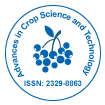Soil Organic Carbon Mapping at Field and Regional Scales Using GIS and Remote Sensing Applications
Received: 04-Jun-2013 / Accepted Date: 05-Jun-2013 / Published Date: 10-Jun-2013 DOI: 10.4172/2329-8863.1000e105
401650Soil Organic Carbon (SOC) is strongly influenced by soil type, and different environmental variables. The SOC has been disturbed continuously by land use change, intensive grazing, cultivation, and for corn (Zea mays L.) cultivation for the ethanol production. This has adversely affected the SOC pool and strongly impacting global warming and climate change. Therefore, a profound understanding is very important to explore conservation practices those are helpful in improving SOC sequestration and mitigating climatic change impacts. An estimate of the SOC pool for the regional, national, and global scale is needed to provide policymakers a basis with which to manage and/or improve this soil C pool in order to address global warming issues and to offset anthropogenic emissions. A critical and credible estimation of this pool is necessary. Because of the spatial heterogeneity of soil C, extensive soil sampling is required at regional and global scales to precisely estimate the SOC pool. However, direct measurement of soil C at these larger scales is expensive and time consuming. Furthermore, sampling density and design, analytical techniques, and calculation methods produce a significant error associated with SOC pool prediction at continental and global scales [1]. Therefore, various estimation techniques have been used extensively to interpolate the SOC at larger scales.
Geostatistical methods have been used effectively to spatially interpolate SOC using different spatial interpolation methods such as kriging [2]. These spatial interpolation methods estimate the values of a point source data (SOC in this case) at unsampled locations with Geographical Information Systems (GIS) modeling [3]. It is well known that SOC depends on climate, topography, hydrology, land use, soil type, and other properties [4]. Hence, a reliable estimate of SOC can be made by considering all of these variables [5]. Therefore, researchers have developed approaches such as RK and MLR to improve estimations over OK. Since then, these approaches have been used effectively across the globe. Regression Kriging (RK) is used to characterize relationships among different environmental variables and involves various combinations of linear regressions and kriging. This approach is based on a normal regression followed by OK with the regression residuals [6]. The RK incorporates the auxiliary terrain information. Multi Linear Regression (MLR) is used to model the linear relationship between a dependent variable and independent variables. Both these approaches incorporate secondary variables, and are superior in terms of their prediction performance as compared to generic geostatistical models such as OK [2]. The RK and MLR approaches are used in predicting general trends in SOC pool of an area, and the relationships between environmental variables and soil C are assumed to be constant across the space [7]. There has been some advancement over previously studied approaches, and subsequently GWR [8] and GWRK [9] approaches have been used and considered better in some conditions compared to previously used approaches such as OK, MLR and RK. In a study conducted by Kumar and colleagues used GWR and GWRK [10] for predicting SOC mapping at larger scale. These researchers have reported that GWR and GWRK performed better compared to RK and MLR approached. However, there are still some disadvantages and advantages for these different approaches those are need to address.
In conclusion, SOC mapping at larger scale can indirectly assess the C sequestration and is useful in predicting the future changes in the C because of climate change, land use change and different land management scenarios [11]. This technique helps in identifying areas that have larger potential for C sequestration [12]. However, the estimation of soil C is not unique due to the natural soil variability within different soil types and landscapes and lack of extensive measured field data [13]. The SOC is spatially and temporally variable across the region and this stock can be estimated at different scales using different GIS and remote sensing applications. These methodologies can be applied anywhere in the world, provided that the data are reliable and meet the criteria for using a specific approach. Researchers have been using different methodologies for estimating the SOC stock at field, regional and global scale. This information will be very useful for the producers and policy makers to explore the potential areas with higher or lower potential for SOC stock.
References
Citation: Kumar S (2013) Soil Organic Carbon Mapping at Field and Regional Scales Using GIS and Remote Sensing Applications. Adv Crop Sci Tech 1:e105. DOI: 10.4172/2329-8863.1000e105
Copyright: © 2013 Kumar S. This is an open-access article distributed under the terms of the Creative Commons Attribution License, which permits unrestricted use, distribution, and reproduction in any medium, provided the original author and source are credited.
Select your language of interest to view the total content in your interested language
Share This Article
Recommended Journals
Open 91جزة« Journals
Article Tools
Article Usage
- Total views: 16204
- [From(publication date): 6-2013 - Jun 15, 2025]
- Breakdown by view type
- HTML page views: 11312
- PDF downloads: 4892
